University Report: Challenges Facing Organization Change Management
VerifiedAdded on 2021/06/17
|13
|2687
|25
Report
AI Summary
This report provides a comprehensive literature review on the challenges of change management within organizations. It explores the difficulties in communicating change to employees, the impact on organizational culture, and specific reasons for resistance. The report delves into strategies for overcoming these challenges, including Lewin's Change Management Model and the ADKAR model, while also examining the role of organizational leaders in facilitating successful change. The critical analysis section identifies gaps in the existing literature, particularly the need for a more in-depth evaluation of the positive impacts of change management and effective communication strategies. The report emphasizes the importance of leadership, communication, and reward systems in fostering high employee performance during periods of organizational change. It provides insights into how businesses can adapt to customer needs and maintain a competitive edge in the market. This report underscores the importance of strategic planning, effective communication, and leadership to achieve organizational objectives.
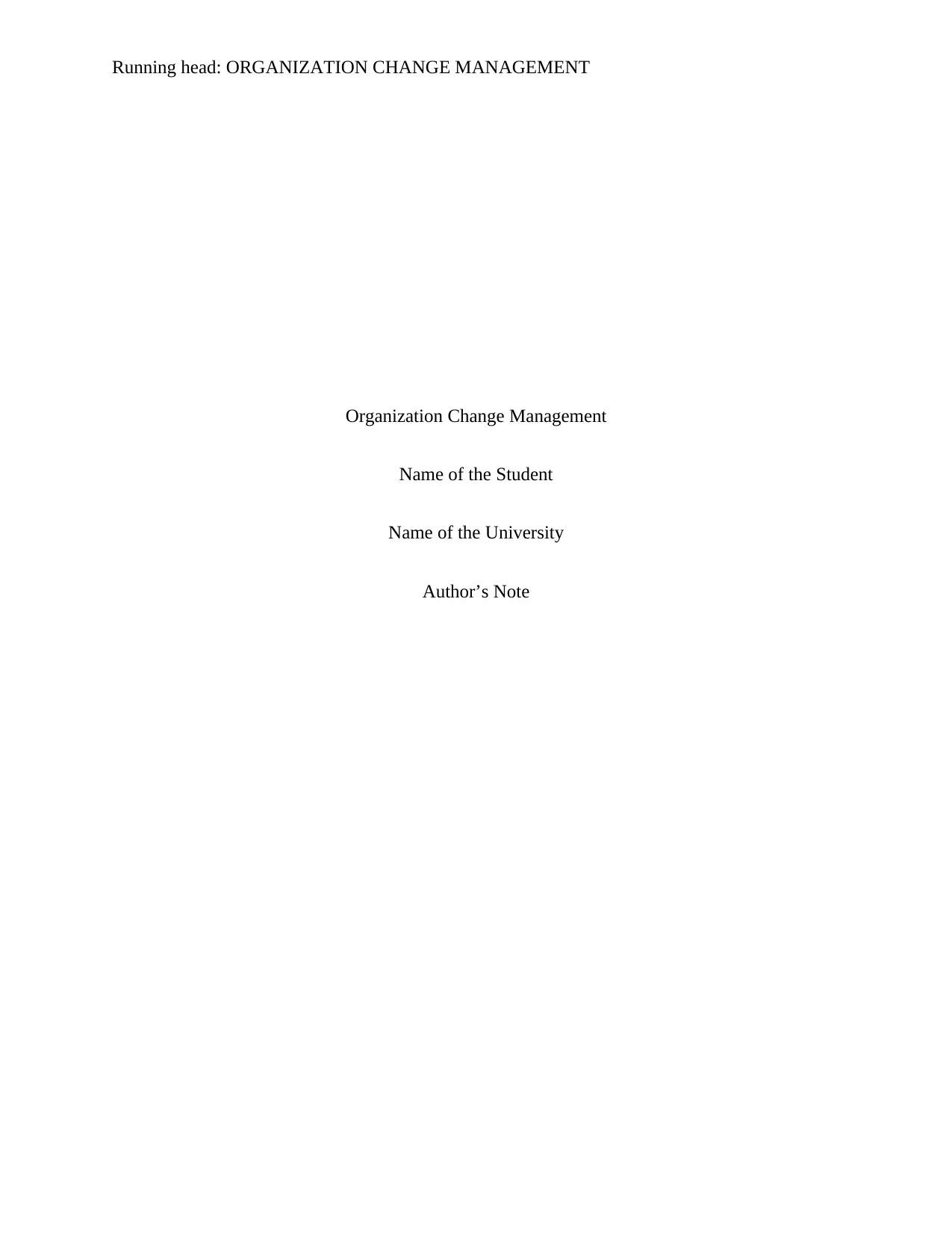
Running head: ORGANIZATION CHANGE MANAGEMENT
Organization Change Management
Name of the Student
Name of the University
Author’s Note
Organization Change Management
Name of the Student
Name of the University
Author’s Note
Paraphrase This Document
Need a fresh take? Get an instant paraphrase of this document with our AI Paraphraser
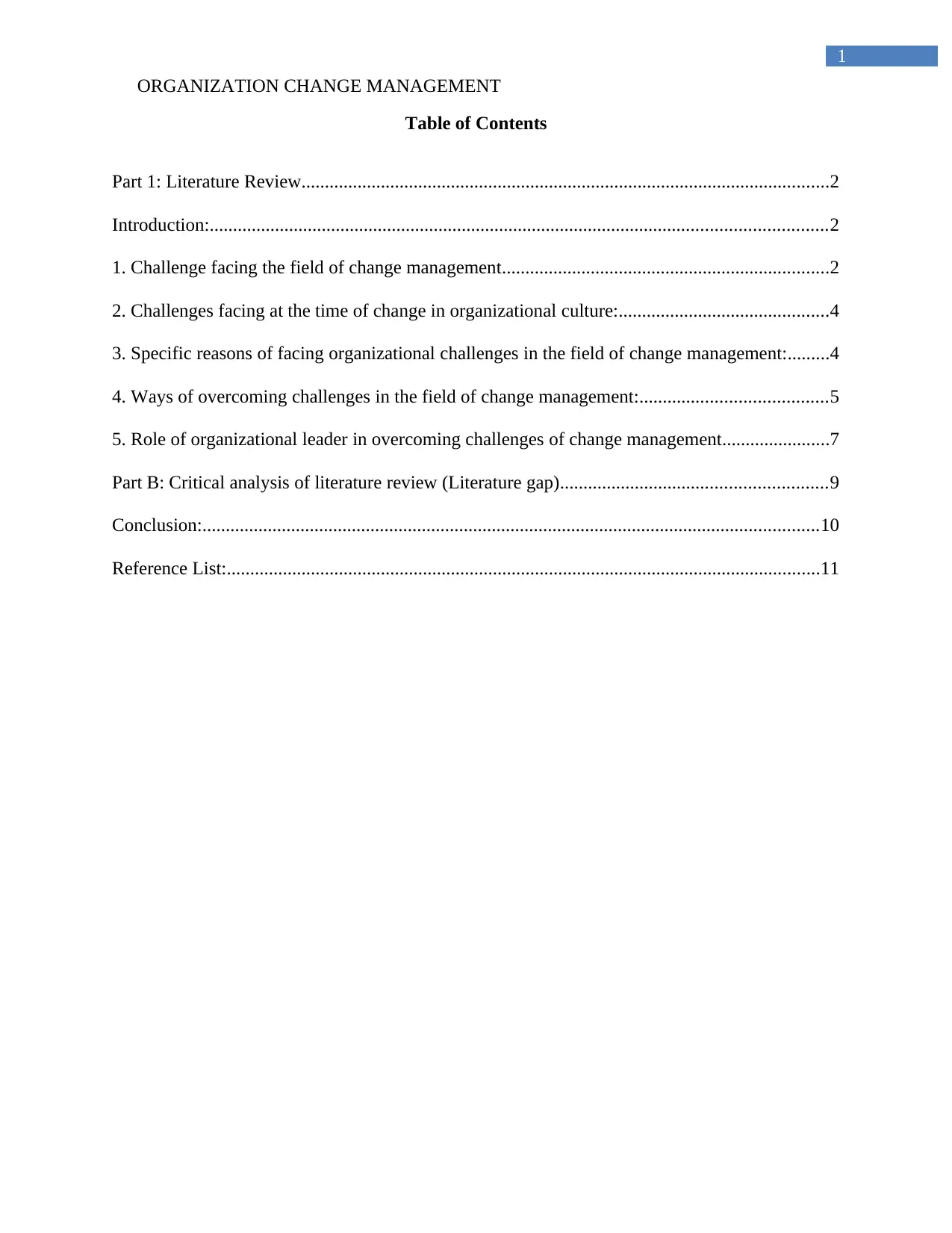
1
ORGANIZATION CHANGE MANAGEMENT
Table of Contents
Part 1: Literature Review.................................................................................................................2
Introduction:....................................................................................................................................2
1. Challenge facing the field of change management......................................................................2
2. Challenges facing at the time of change in organizational culture:.............................................4
3. Specific reasons of facing organizational challenges in the field of change management:.........4
4. Ways of overcoming challenges in the field of change management:........................................5
5. Role of organizational leader in overcoming challenges of change management.......................7
Part B: Critical analysis of literature review (Literature gap).........................................................9
Conclusion:....................................................................................................................................10
Reference List:...............................................................................................................................11
ORGANIZATION CHANGE MANAGEMENT
Table of Contents
Part 1: Literature Review.................................................................................................................2
Introduction:....................................................................................................................................2
1. Challenge facing the field of change management......................................................................2
2. Challenges facing at the time of change in organizational culture:.............................................4
3. Specific reasons of facing organizational challenges in the field of change management:.........4
4. Ways of overcoming challenges in the field of change management:........................................5
5. Role of organizational leader in overcoming challenges of change management.......................7
Part B: Critical analysis of literature review (Literature gap).........................................................9
Conclusion:....................................................................................................................................10
Reference List:...............................................................................................................................11
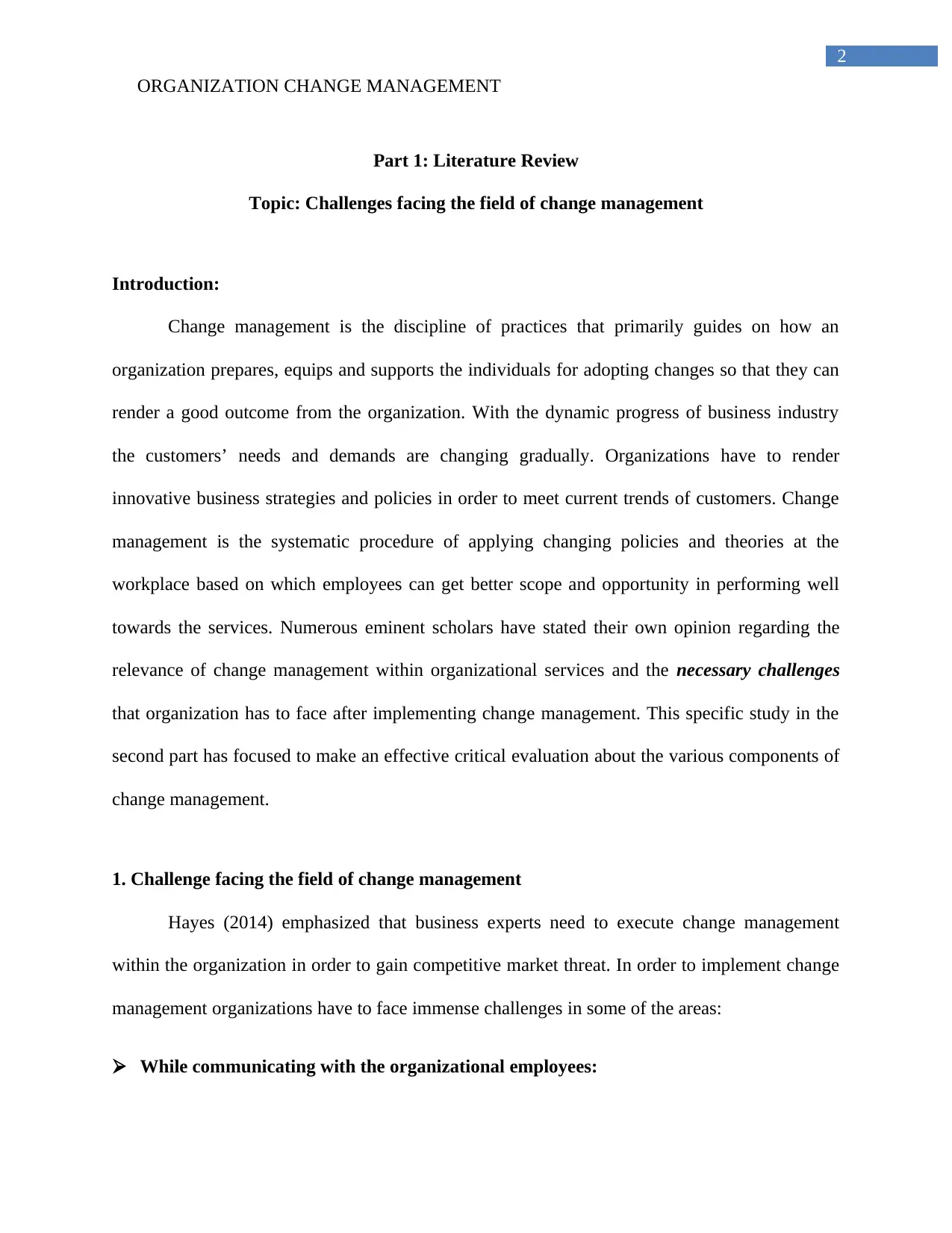
2
ORGANIZATION CHANGE MANAGEMENT
Part 1: Literature Review
Topic: Challenges facing the field of change management
Introduction:
Change management is the discipline of practices that primarily guides on how an
organization prepares, equips and supports the individuals for adopting changes so that they can
render a good outcome from the organization. With the dynamic progress of business industry
the customers’ needs and demands are changing gradually. Organizations have to render
innovative business strategies and policies in order to meet current trends of customers. Change
management is the systematic procedure of applying changing policies and theories at the
workplace based on which employees can get better scope and opportunity in performing well
towards the services. Numerous eminent scholars have stated their own opinion regarding the
relevance of change management within organizational services and the necessary challenges
that organization has to face after implementing change management. This specific study in the
second part has focused to make an effective critical evaluation about the various components of
change management.
1. Challenge facing the field of change management
Hayes (2014) emphasized that business experts need to execute change management
within the organization in order to gain competitive market threat. In order to implement change
management organizations have to face immense challenges in some of the areas:
While communicating with the organizational employees:
ORGANIZATION CHANGE MANAGEMENT
Part 1: Literature Review
Topic: Challenges facing the field of change management
Introduction:
Change management is the discipline of practices that primarily guides on how an
organization prepares, equips and supports the individuals for adopting changes so that they can
render a good outcome from the organization. With the dynamic progress of business industry
the customers’ needs and demands are changing gradually. Organizations have to render
innovative business strategies and policies in order to meet current trends of customers. Change
management is the systematic procedure of applying changing policies and theories at the
workplace based on which employees can get better scope and opportunity in performing well
towards the services. Numerous eminent scholars have stated their own opinion regarding the
relevance of change management within organizational services and the necessary challenges
that organization has to face after implementing change management. This specific study in the
second part has focused to make an effective critical evaluation about the various components of
change management.
1. Challenge facing the field of change management
Hayes (2014) emphasized that business experts need to execute change management
within the organization in order to gain competitive market threat. In order to implement change
management organizations have to face immense challenges in some of the areas:
While communicating with the organizational employees:
⊘ This is a preview!⊘
Do you want full access?
Subscribe today to unlock all pages.

Trusted by 1+ million students worldwide
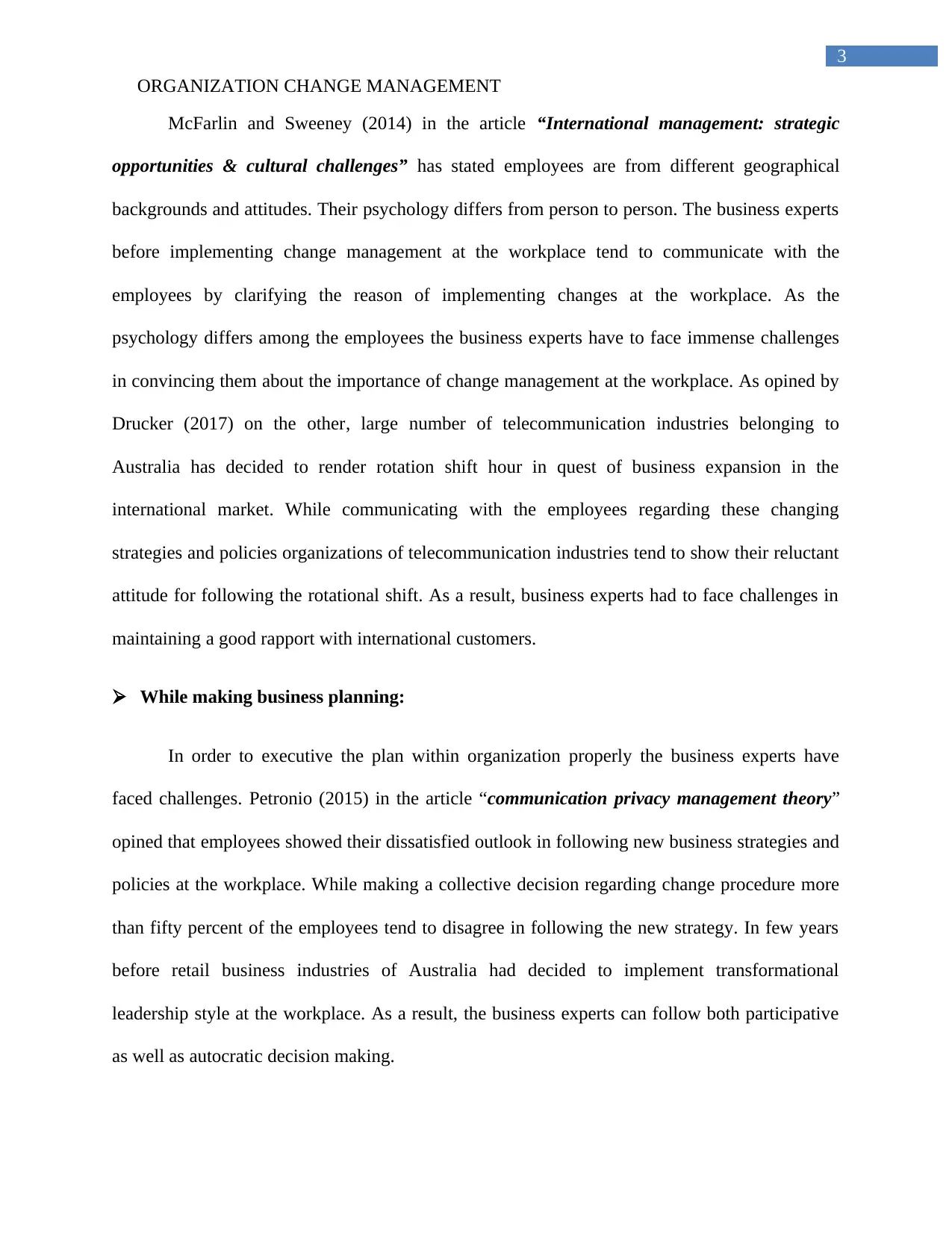
3
ORGANIZATION CHANGE MANAGEMENT
McFarlin and Sweeney (2014) in the article “International management: strategic
opportunities & cultural challenges” has stated employees are from different geographical
backgrounds and attitudes. Their psychology differs from person to person. The business experts
before implementing change management at the workplace tend to communicate with the
employees by clarifying the reason of implementing changes at the workplace. As the
psychology differs among the employees the business experts have to face immense challenges
in convincing them about the importance of change management at the workplace. As opined by
Drucker (2017) on the other, large number of telecommunication industries belonging to
Australia has decided to render rotation shift hour in quest of business expansion in the
international market. While communicating with the employees regarding these changing
strategies and policies organizations of telecommunication industries tend to show their reluctant
attitude for following the rotational shift. As a result, business experts had to face challenges in
maintaining a good rapport with international customers.
While making business planning:
In order to executive the plan within organization properly the business experts have
faced challenges. Petronio (2015) in the article “communication privacy management theory”
opined that employees showed their dissatisfied outlook in following new business strategies and
policies at the workplace. While making a collective decision regarding change procedure more
than fifty percent of the employees tend to disagree in following the new strategy. In few years
before retail business industries of Australia had decided to implement transformational
leadership style at the workplace. As a result, the business experts can follow both participative
as well as autocratic decision making.
ORGANIZATION CHANGE MANAGEMENT
McFarlin and Sweeney (2014) in the article “International management: strategic
opportunities & cultural challenges” has stated employees are from different geographical
backgrounds and attitudes. Their psychology differs from person to person. The business experts
before implementing change management at the workplace tend to communicate with the
employees by clarifying the reason of implementing changes at the workplace. As the
psychology differs among the employees the business experts have to face immense challenges
in convincing them about the importance of change management at the workplace. As opined by
Drucker (2017) on the other, large number of telecommunication industries belonging to
Australia has decided to render rotation shift hour in quest of business expansion in the
international market. While communicating with the employees regarding these changing
strategies and policies organizations of telecommunication industries tend to show their reluctant
attitude for following the rotational shift. As a result, business experts had to face challenges in
maintaining a good rapport with international customers.
While making business planning:
In order to executive the plan within organization properly the business experts have
faced challenges. Petronio (2015) in the article “communication privacy management theory”
opined that employees showed their dissatisfied outlook in following new business strategies and
policies at the workplace. While making a collective decision regarding change procedure more
than fifty percent of the employees tend to disagree in following the new strategy. In few years
before retail business industries of Australia had decided to implement transformational
leadership style at the workplace. As a result, the business experts can follow both participative
as well as autocratic decision making.
Paraphrase This Document
Need a fresh take? Get an instant paraphrase of this document with our AI Paraphraser
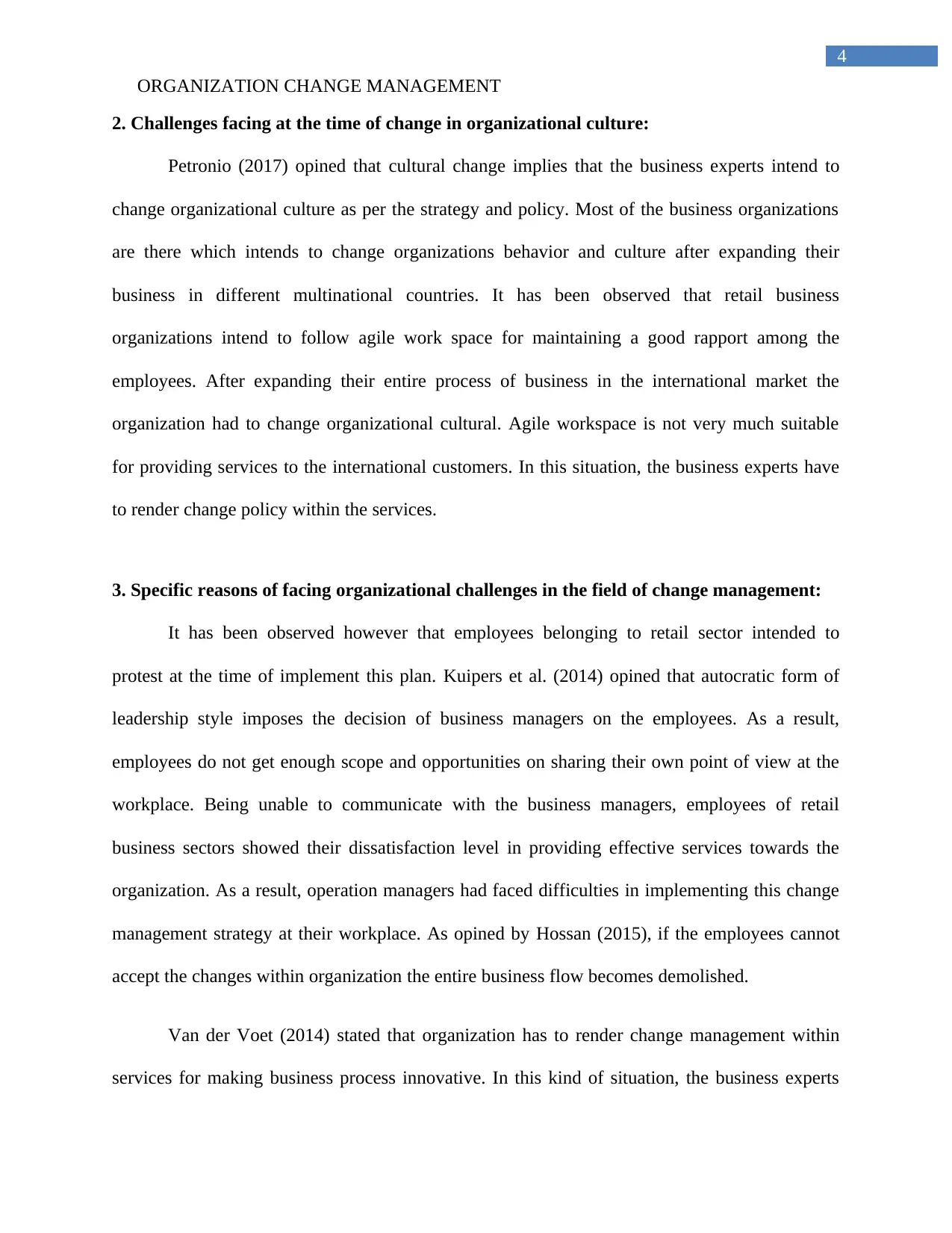
4
ORGANIZATION CHANGE MANAGEMENT
2. Challenges facing at the time of change in organizational culture:
Petronio (2017) opined that cultural change implies that the business experts intend to
change organizational culture as per the strategy and policy. Most of the business organizations
are there which intends to change organizations behavior and culture after expanding their
business in different multinational countries. It has been observed that retail business
organizations intend to follow agile work space for maintaining a good rapport among the
employees. After expanding their entire process of business in the international market the
organization had to change organizational cultural. Agile workspace is not very much suitable
for providing services to the international customers. In this situation, the business experts have
to render change policy within the services.
3. Specific reasons of facing organizational challenges in the field of change management:
It has been observed however that employees belonging to retail sector intended to
protest at the time of implement this plan. Kuipers et al. (2014) opined that autocratic form of
leadership style imposes the decision of business managers on the employees. As a result,
employees do not get enough scope and opportunities on sharing their own point of view at the
workplace. Being unable to communicate with the business managers, employees of retail
business sectors showed their dissatisfaction level in providing effective services towards the
organization. As a result, operation managers had faced difficulties in implementing this change
management strategy at their workplace. As opined by Hossan (2015), if the employees cannot
accept the changes within organization the entire business flow becomes demolished.
Van der Voet (2014) stated that organization has to render change management within
services for making business process innovative. In this kind of situation, the business experts
ORGANIZATION CHANGE MANAGEMENT
2. Challenges facing at the time of change in organizational culture:
Petronio (2017) opined that cultural change implies that the business experts intend to
change organizational culture as per the strategy and policy. Most of the business organizations
are there which intends to change organizations behavior and culture after expanding their
business in different multinational countries. It has been observed that retail business
organizations intend to follow agile work space for maintaining a good rapport among the
employees. After expanding their entire process of business in the international market the
organization had to change organizational cultural. Agile workspace is not very much suitable
for providing services to the international customers. In this situation, the business experts have
to render change policy within the services.
3. Specific reasons of facing organizational challenges in the field of change management:
It has been observed however that employees belonging to retail sector intended to
protest at the time of implement this plan. Kuipers et al. (2014) opined that autocratic form of
leadership style imposes the decision of business managers on the employees. As a result,
employees do not get enough scope and opportunities on sharing their own point of view at the
workplace. Being unable to communicate with the business managers, employees of retail
business sectors showed their dissatisfaction level in providing effective services towards the
organization. As a result, operation managers had faced difficulties in implementing this change
management strategy at their workplace. As opined by Hossan (2015), if the employees cannot
accept the changes within organization the entire business flow becomes demolished.
Van der Voet (2014) stated that organization has to render change management within
services for making business process innovative. In this kind of situation, the business experts
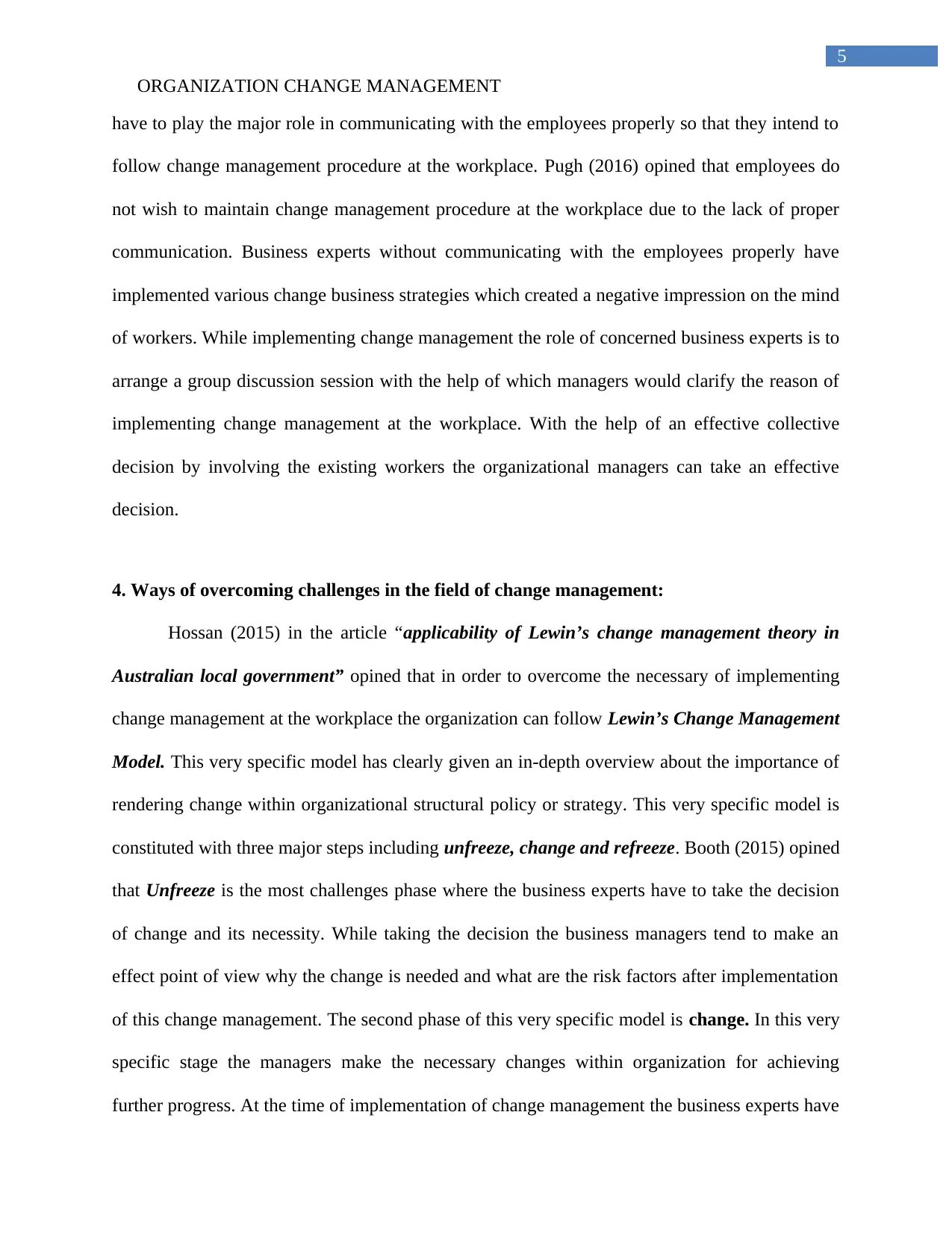
5
ORGANIZATION CHANGE MANAGEMENT
have to play the major role in communicating with the employees properly so that they intend to
follow change management procedure at the workplace. Pugh (2016) opined that employees do
not wish to maintain change management procedure at the workplace due to the lack of proper
communication. Business experts without communicating with the employees properly have
implemented various change business strategies which created a negative impression on the mind
of workers. While implementing change management the role of concerned business experts is to
arrange a group discussion session with the help of which managers would clarify the reason of
implementing change management at the workplace. With the help of an effective collective
decision by involving the existing workers the organizational managers can take an effective
decision.
4. Ways of overcoming challenges in the field of change management:
Hossan (2015) in the article “applicability of Lewin’s change management theory in
Australian local government” opined that in order to overcome the necessary of implementing
change management at the workplace the organization can follow Lewin’s Change Management
Model. This very specific model has clearly given an in-depth overview about the importance of
rendering change within organizational structural policy or strategy. This very specific model is
constituted with three major steps including unfreeze, change and refreeze. Booth (2015) opined
that Unfreeze is the most challenges phase where the business experts have to take the decision
of change and its necessity. While taking the decision the business managers tend to make an
effect point of view why the change is needed and what are the risk factors after implementation
of this change management. The second phase of this very specific model is change. In this very
specific stage the managers make the necessary changes within organization for achieving
further progress. At the time of implementation of change management the business experts have
ORGANIZATION CHANGE MANAGEMENT
have to play the major role in communicating with the employees properly so that they intend to
follow change management procedure at the workplace. Pugh (2016) opined that employees do
not wish to maintain change management procedure at the workplace due to the lack of proper
communication. Business experts without communicating with the employees properly have
implemented various change business strategies which created a negative impression on the mind
of workers. While implementing change management the role of concerned business experts is to
arrange a group discussion session with the help of which managers would clarify the reason of
implementing change management at the workplace. With the help of an effective collective
decision by involving the existing workers the organizational managers can take an effective
decision.
4. Ways of overcoming challenges in the field of change management:
Hossan (2015) in the article “applicability of Lewin’s change management theory in
Australian local government” opined that in order to overcome the necessary of implementing
change management at the workplace the organization can follow Lewin’s Change Management
Model. This very specific model has clearly given an in-depth overview about the importance of
rendering change within organizational structural policy or strategy. This very specific model is
constituted with three major steps including unfreeze, change and refreeze. Booth (2015) opined
that Unfreeze is the most challenges phase where the business experts have to take the decision
of change and its necessity. While taking the decision the business managers tend to make an
effect point of view why the change is needed and what are the risk factors after implementation
of this change management. The second phase of this very specific model is change. In this very
specific stage the managers make the necessary changes within organization for achieving
further progress. At the time of implementation of change management the business experts have
⊘ This is a preview!⊘
Do you want full access?
Subscribe today to unlock all pages.

Trusted by 1+ million students worldwide
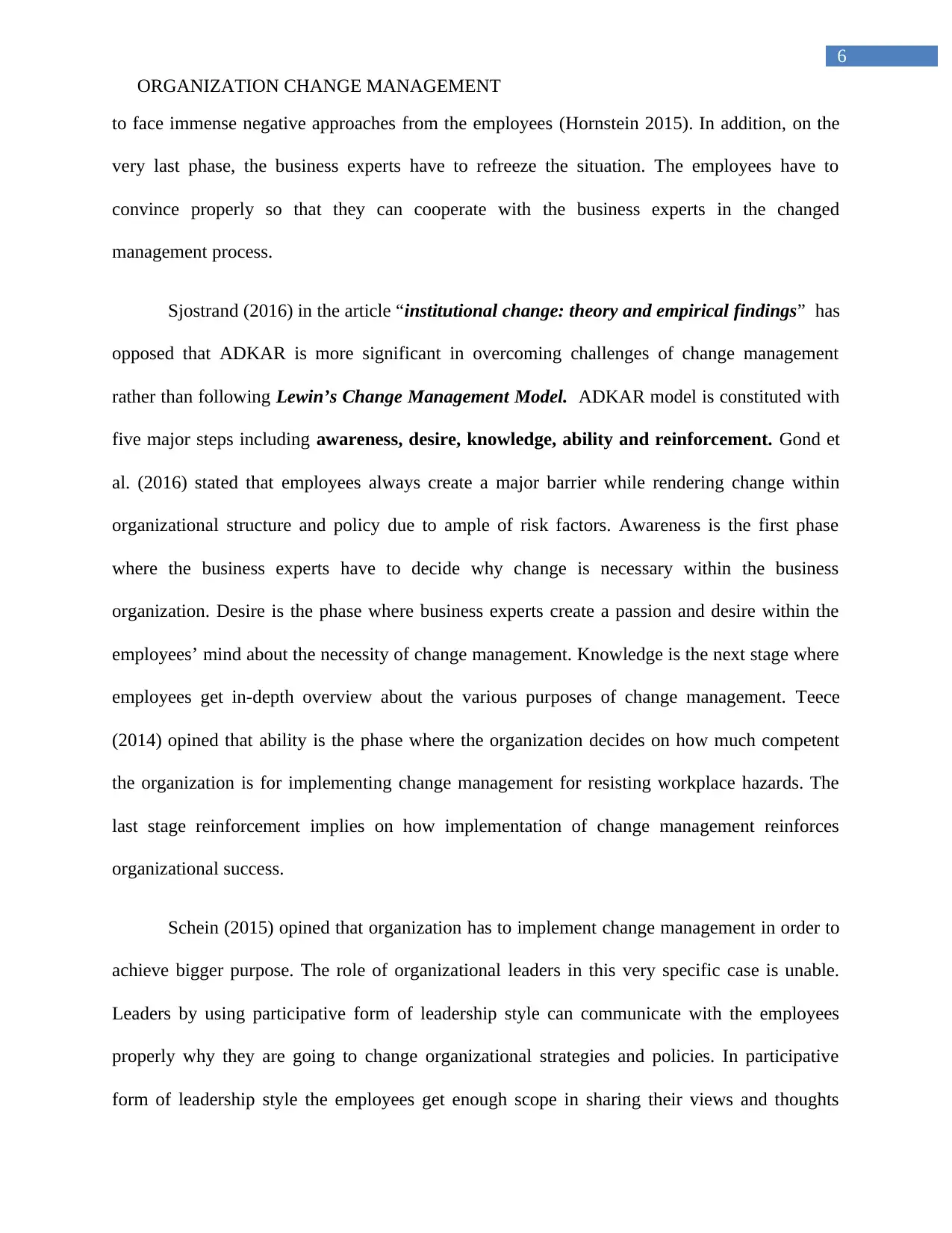
6
ORGANIZATION CHANGE MANAGEMENT
to face immense negative approaches from the employees (Hornstein 2015). In addition, on the
very last phase, the business experts have to refreeze the situation. The employees have to
convince properly so that they can cooperate with the business experts in the changed
management process.
Sjostrand (2016) in the article “institutional change: theory and empirical findings” has
opposed that ADKAR is more significant in overcoming challenges of change management
rather than following Lewin’s Change Management Model. ADKAR model is constituted with
five major steps including awareness, desire, knowledge, ability and reinforcement. Gond et
al. (2016) stated that employees always create a major barrier while rendering change within
organizational structure and policy due to ample of risk factors. Awareness is the first phase
where the business experts have to decide why change is necessary within the business
organization. Desire is the phase where business experts create a passion and desire within the
employees’ mind about the necessity of change management. Knowledge is the next stage where
employees get in-depth overview about the various purposes of change management. Teece
(2014) opined that ability is the phase where the organization decides on how much competent
the organization is for implementing change management for resisting workplace hazards. The
last stage reinforcement implies on how implementation of change management reinforces
organizational success.
Schein (2015) opined that organization has to implement change management in order to
achieve bigger purpose. The role of organizational leaders in this very specific case is unable.
Leaders by using participative form of leadership style can communicate with the employees
properly why they are going to change organizational strategies and policies. In participative
form of leadership style the employees get enough scope in sharing their views and thoughts
ORGANIZATION CHANGE MANAGEMENT
to face immense negative approaches from the employees (Hornstein 2015). In addition, on the
very last phase, the business experts have to refreeze the situation. The employees have to
convince properly so that they can cooperate with the business experts in the changed
management process.
Sjostrand (2016) in the article “institutional change: theory and empirical findings” has
opposed that ADKAR is more significant in overcoming challenges of change management
rather than following Lewin’s Change Management Model. ADKAR model is constituted with
five major steps including awareness, desire, knowledge, ability and reinforcement. Gond et
al. (2016) stated that employees always create a major barrier while rendering change within
organizational structure and policy due to ample of risk factors. Awareness is the first phase
where the business experts have to decide why change is necessary within the business
organization. Desire is the phase where business experts create a passion and desire within the
employees’ mind about the necessity of change management. Knowledge is the next stage where
employees get in-depth overview about the various purposes of change management. Teece
(2014) opined that ability is the phase where the organization decides on how much competent
the organization is for implementing change management for resisting workplace hazards. The
last stage reinforcement implies on how implementation of change management reinforces
organizational success.
Schein (2015) opined that organization has to implement change management in order to
achieve bigger purpose. The role of organizational leaders in this very specific case is unable.
Leaders by using participative form of leadership style can communicate with the employees
properly why they are going to change organizational strategies and policies. In participative
form of leadership style the employees get enough scope in sharing their views and thoughts
Paraphrase This Document
Need a fresh take? Get an instant paraphrase of this document with our AI Paraphraser
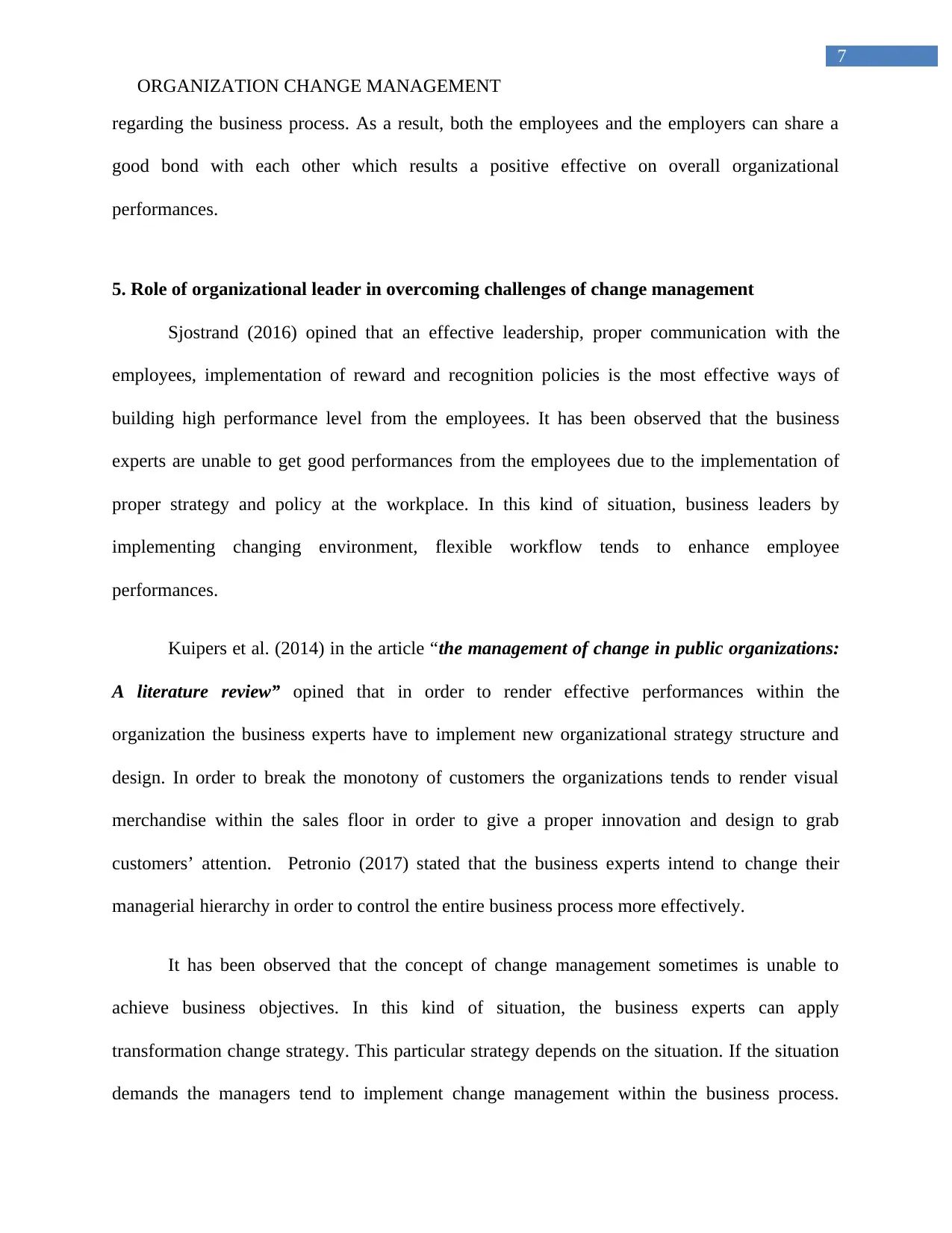
7
ORGANIZATION CHANGE MANAGEMENT
regarding the business process. As a result, both the employees and the employers can share a
good bond with each other which results a positive effective on overall organizational
performances.
5. Role of organizational leader in overcoming challenges of change management
Sjostrand (2016) opined that an effective leadership, proper communication with the
employees, implementation of reward and recognition policies is the most effective ways of
building high performance level from the employees. It has been observed that the business
experts are unable to get good performances from the employees due to the implementation of
proper strategy and policy at the workplace. In this kind of situation, business leaders by
implementing changing environment, flexible workflow tends to enhance employee
performances.
Kuipers et al. (2014) in the article “the management of change in public organizations:
A literature review” opined that in order to render effective performances within the
organization the business experts have to implement new organizational strategy structure and
design. In order to break the monotony of customers the organizations tends to render visual
merchandise within the sales floor in order to give a proper innovation and design to grab
customers’ attention. Petronio (2017) stated that the business experts intend to change their
managerial hierarchy in order to control the entire business process more effectively.
It has been observed that the concept of change management sometimes is unable to
achieve business objectives. In this kind of situation, the business experts can apply
transformation change strategy. This particular strategy depends on the situation. If the situation
demands the managers tend to implement change management within the business process.
ORGANIZATION CHANGE MANAGEMENT
regarding the business process. As a result, both the employees and the employers can share a
good bond with each other which results a positive effective on overall organizational
performances.
5. Role of organizational leader in overcoming challenges of change management
Sjostrand (2016) opined that an effective leadership, proper communication with the
employees, implementation of reward and recognition policies is the most effective ways of
building high performance level from the employees. It has been observed that the business
experts are unable to get good performances from the employees due to the implementation of
proper strategy and policy at the workplace. In this kind of situation, business leaders by
implementing changing environment, flexible workflow tends to enhance employee
performances.
Kuipers et al. (2014) in the article “the management of change in public organizations:
A literature review” opined that in order to render effective performances within the
organization the business experts have to implement new organizational strategy structure and
design. In order to break the monotony of customers the organizations tends to render visual
merchandise within the sales floor in order to give a proper innovation and design to grab
customers’ attention. Petronio (2017) stated that the business experts intend to change their
managerial hierarchy in order to control the entire business process more effectively.
It has been observed that the concept of change management sometimes is unable to
achieve business objectives. In this kind of situation, the business experts can apply
transformation change strategy. This particular strategy depends on the situation. If the situation
demands the managers tend to implement change management within the business process.
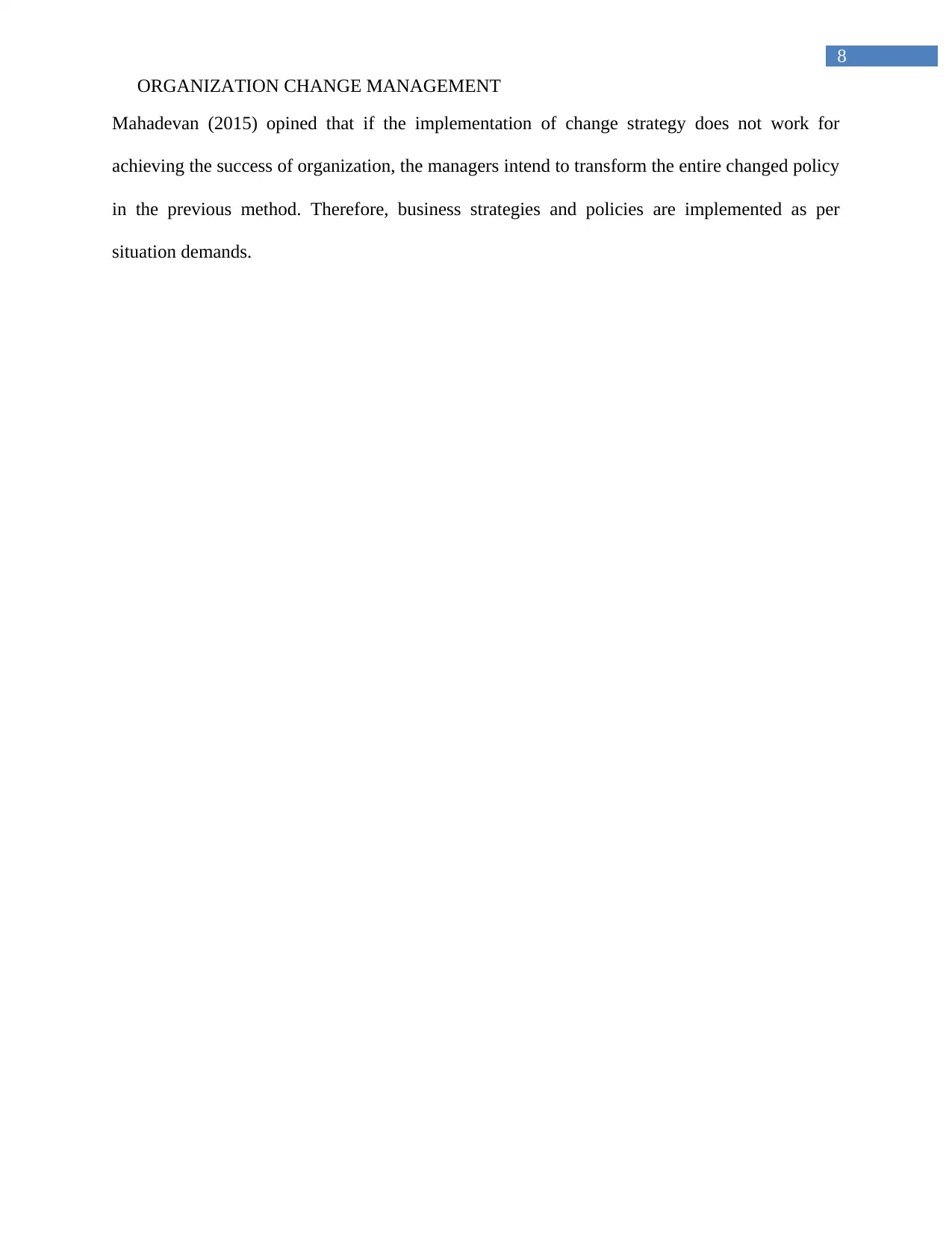
8
ORGANIZATION CHANGE MANAGEMENT
Mahadevan (2015) opined that if the implementation of change strategy does not work for
achieving the success of organization, the managers intend to transform the entire changed policy
in the previous method. Therefore, business strategies and policies are implemented as per
situation demands.
ORGANIZATION CHANGE MANAGEMENT
Mahadevan (2015) opined that if the implementation of change strategy does not work for
achieving the success of organization, the managers intend to transform the entire changed policy
in the previous method. Therefore, business strategies and policies are implemented as per
situation demands.
⊘ This is a preview!⊘
Do you want full access?
Subscribe today to unlock all pages.

Trusted by 1+ million students worldwide
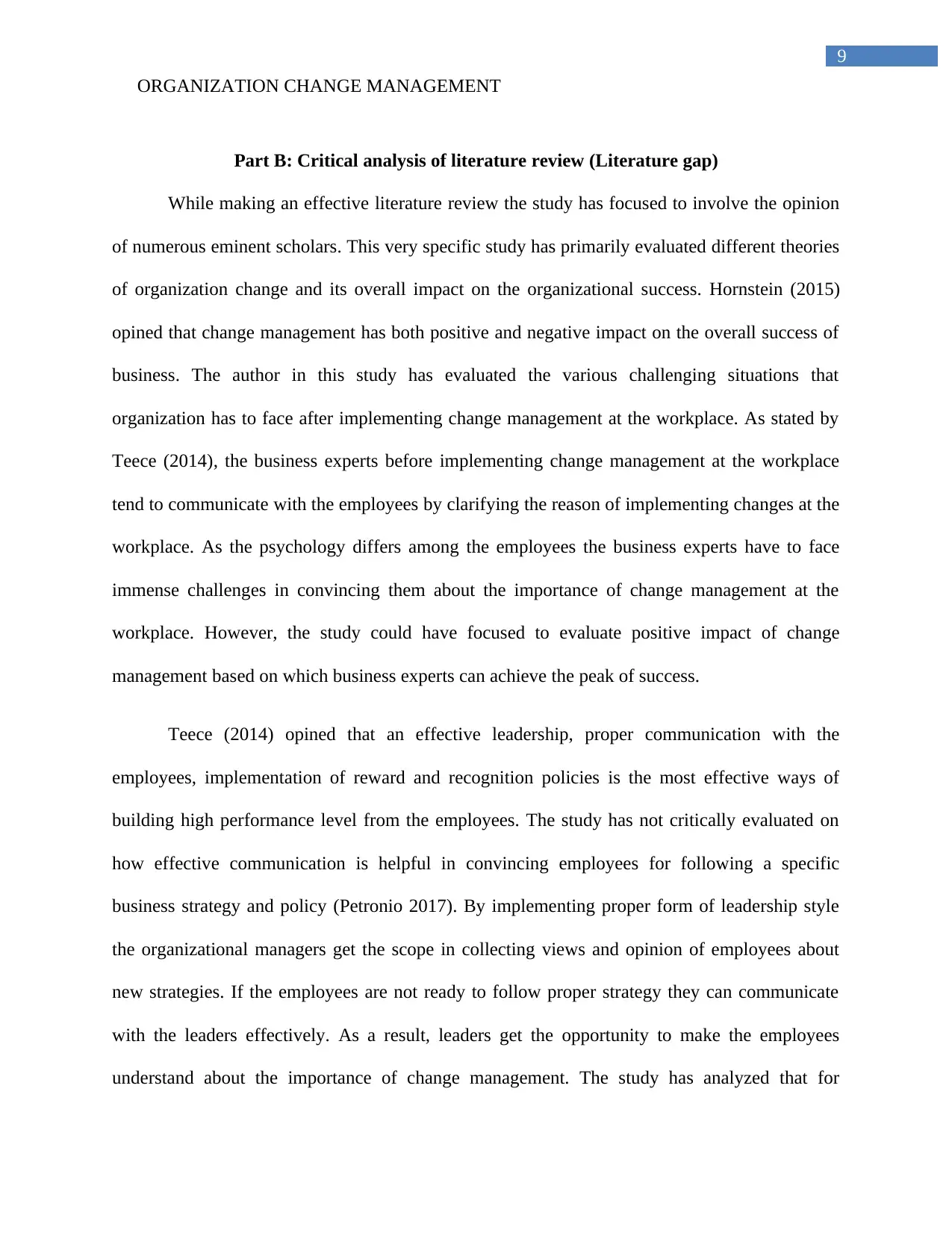
9
ORGANIZATION CHANGE MANAGEMENT
Part B: Critical analysis of literature review (Literature gap)
While making an effective literature review the study has focused to involve the opinion
of numerous eminent scholars. This very specific study has primarily evaluated different theories
of organization change and its overall impact on the organizational success. Hornstein (2015)
opined that change management has both positive and negative impact on the overall success of
business. The author in this study has evaluated the various challenging situations that
organization has to face after implementing change management at the workplace. As stated by
Teece (2014), the business experts before implementing change management at the workplace
tend to communicate with the employees by clarifying the reason of implementing changes at the
workplace. As the psychology differs among the employees the business experts have to face
immense challenges in convincing them about the importance of change management at the
workplace. However, the study could have focused to evaluate positive impact of change
management based on which business experts can achieve the peak of success.
Teece (2014) opined that an effective leadership, proper communication with the
employees, implementation of reward and recognition policies is the most effective ways of
building high performance level from the employees. The study has not critically evaluated on
how effective communication is helpful in convincing employees for following a specific
business strategy and policy (Petronio 2017). By implementing proper form of leadership style
the organizational managers get the scope in collecting views and opinion of employees about
new strategies. If the employees are not ready to follow proper strategy they can communicate
with the leaders effectively. As a result, leaders get the opportunity to make the employees
understand about the importance of change management. The study has analyzed that for
ORGANIZATION CHANGE MANAGEMENT
Part B: Critical analysis of literature review (Literature gap)
While making an effective literature review the study has focused to involve the opinion
of numerous eminent scholars. This very specific study has primarily evaluated different theories
of organization change and its overall impact on the organizational success. Hornstein (2015)
opined that change management has both positive and negative impact on the overall success of
business. The author in this study has evaluated the various challenging situations that
organization has to face after implementing change management at the workplace. As stated by
Teece (2014), the business experts before implementing change management at the workplace
tend to communicate with the employees by clarifying the reason of implementing changes at the
workplace. As the psychology differs among the employees the business experts have to face
immense challenges in convincing them about the importance of change management at the
workplace. However, the study could have focused to evaluate positive impact of change
management based on which business experts can achieve the peak of success.
Teece (2014) opined that an effective leadership, proper communication with the
employees, implementation of reward and recognition policies is the most effective ways of
building high performance level from the employees. The study has not critically evaluated on
how effective communication is helpful in convincing employees for following a specific
business strategy and policy (Petronio 2017). By implementing proper form of leadership style
the organizational managers get the scope in collecting views and opinion of employees about
new strategies. If the employees are not ready to follow proper strategy they can communicate
with the leaders effectively. As a result, leaders get the opportunity to make the employees
understand about the importance of change management. The study has analyzed that for
Paraphrase This Document
Need a fresh take? Get an instant paraphrase of this document with our AI Paraphraser
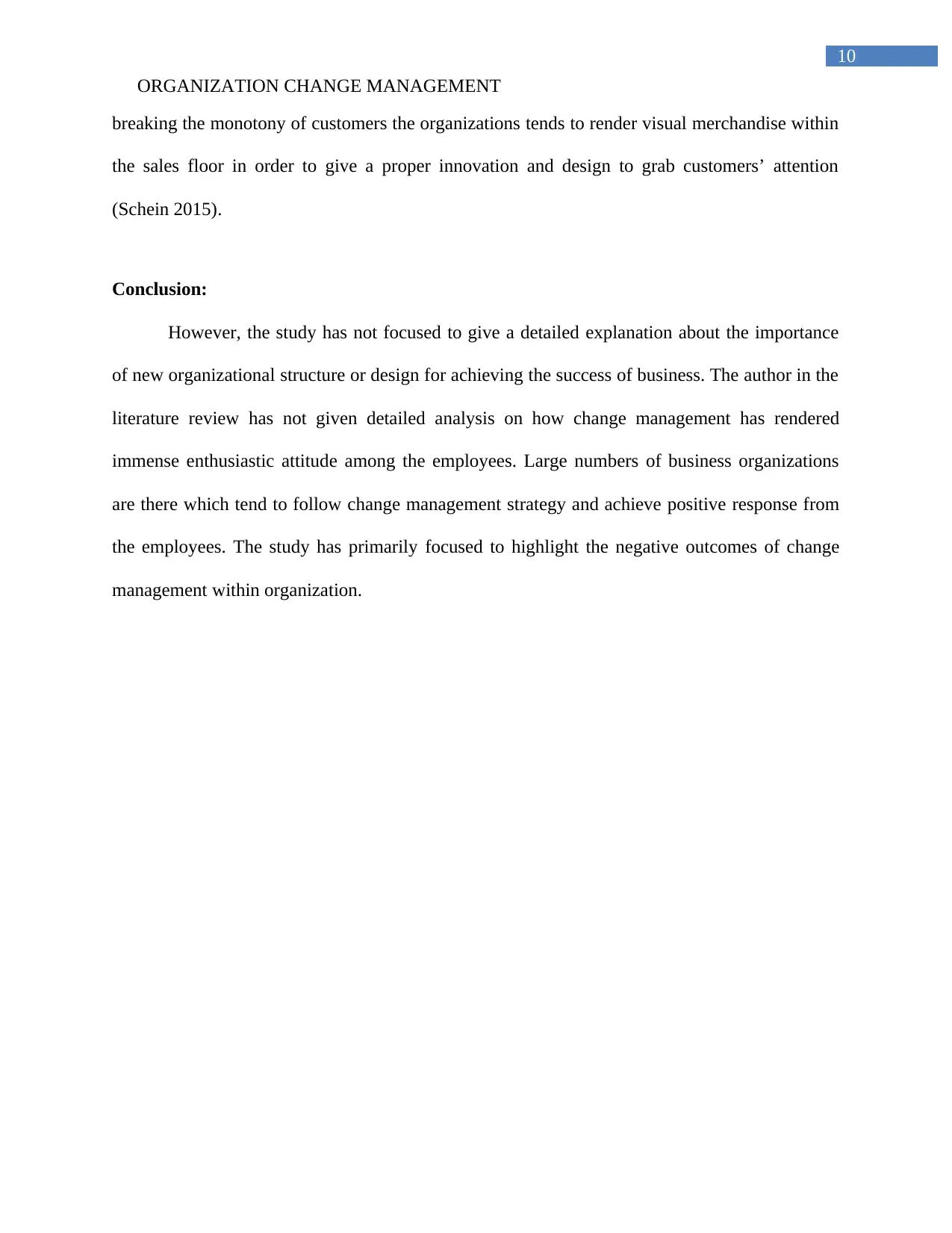
10
ORGANIZATION CHANGE MANAGEMENT
breaking the monotony of customers the organizations tends to render visual merchandise within
the sales floor in order to give a proper innovation and design to grab customers’ attention
(Schein 2015).
Conclusion:
However, the study has not focused to give a detailed explanation about the importance
of new organizational structure or design for achieving the success of business. The author in the
literature review has not given detailed analysis on how change management has rendered
immense enthusiastic attitude among the employees. Large numbers of business organizations
are there which tend to follow change management strategy and achieve positive response from
the employees. The study has primarily focused to highlight the negative outcomes of change
management within organization.
ORGANIZATION CHANGE MANAGEMENT
breaking the monotony of customers the organizations tends to render visual merchandise within
the sales floor in order to give a proper innovation and design to grab customers’ attention
(Schein 2015).
Conclusion:
However, the study has not focused to give a detailed explanation about the importance
of new organizational structure or design for achieving the success of business. The author in the
literature review has not given detailed analysis on how change management has rendered
immense enthusiastic attitude among the employees. Large numbers of business organizations
are there which tend to follow change management strategy and achieve positive response from
the employees. The study has primarily focused to highlight the negative outcomes of change
management within organization.
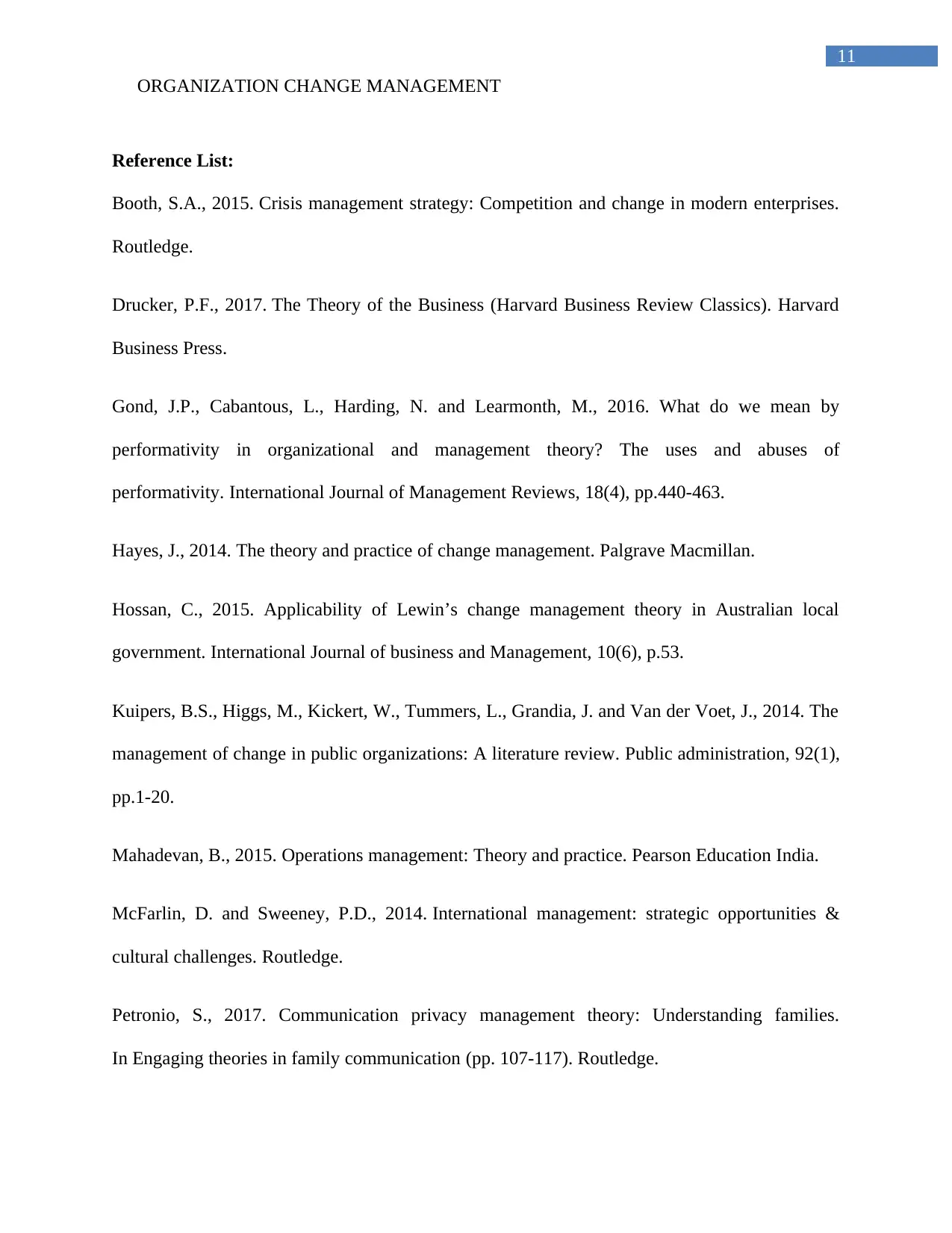
11
ORGANIZATION CHANGE MANAGEMENT
Reference List:
Booth, S.A., 2015. Crisis management strategy: Competition and change in modern enterprises.
Routledge.
Drucker, P.F., 2017. The Theory of the Business (Harvard Business Review Classics). Harvard
Business Press.
Gond, J.P., Cabantous, L., Harding, N. and Learmonth, M., 2016. What do we mean by
performativity in organizational and management theory? The uses and abuses of
performativity. International Journal of Management Reviews, 18(4), pp.440-463.
Hayes, J., 2014. The theory and practice of change management. Palgrave Macmillan.
Hossan, C., 2015. Applicability of Lewin’s change management theory in Australian local
government. International Journal of business and Management, 10(6), p.53.
Kuipers, B.S., Higgs, M., Kickert, W., Tummers, L., Grandia, J. and Van der Voet, J., 2014. The
management of change in public organizations: A literature review. Public administration, 92(1),
pp.1-20.
Mahadevan, B., 2015. Operations management: Theory and practice. Pearson Education India.
McFarlin, D. and Sweeney, P.D., 2014. International management: strategic opportunities &
cultural challenges. Routledge.
Petronio, S., 2017. Communication privacy management theory: Understanding families.
In Engaging theories in family communication (pp. 107-117). Routledge.
ORGANIZATION CHANGE MANAGEMENT
Reference List:
Booth, S.A., 2015. Crisis management strategy: Competition and change in modern enterprises.
Routledge.
Drucker, P.F., 2017. The Theory of the Business (Harvard Business Review Classics). Harvard
Business Press.
Gond, J.P., Cabantous, L., Harding, N. and Learmonth, M., 2016. What do we mean by
performativity in organizational and management theory? The uses and abuses of
performativity. International Journal of Management Reviews, 18(4), pp.440-463.
Hayes, J., 2014. The theory and practice of change management. Palgrave Macmillan.
Hossan, C., 2015. Applicability of Lewin’s change management theory in Australian local
government. International Journal of business and Management, 10(6), p.53.
Kuipers, B.S., Higgs, M., Kickert, W., Tummers, L., Grandia, J. and Van der Voet, J., 2014. The
management of change in public organizations: A literature review. Public administration, 92(1),
pp.1-20.
Mahadevan, B., 2015. Operations management: Theory and practice. Pearson Education India.
McFarlin, D. and Sweeney, P.D., 2014. International management: strategic opportunities &
cultural challenges. Routledge.
Petronio, S., 2017. Communication privacy management theory: Understanding families.
In Engaging theories in family communication (pp. 107-117). Routledge.
⊘ This is a preview!⊘
Do you want full access?
Subscribe today to unlock all pages.

Trusted by 1+ million students worldwide
1 out of 13
Related Documents
Your All-in-One AI-Powered Toolkit for Academic Success.
+13062052269
info@desklib.com
Available 24*7 on WhatsApp / Email
![[object Object]](/_next/static/media/star-bottom.7253800d.svg)
Unlock your academic potential
Copyright © 2020–2025 A2Z Services. All Rights Reserved. Developed and managed by ZUCOL.





